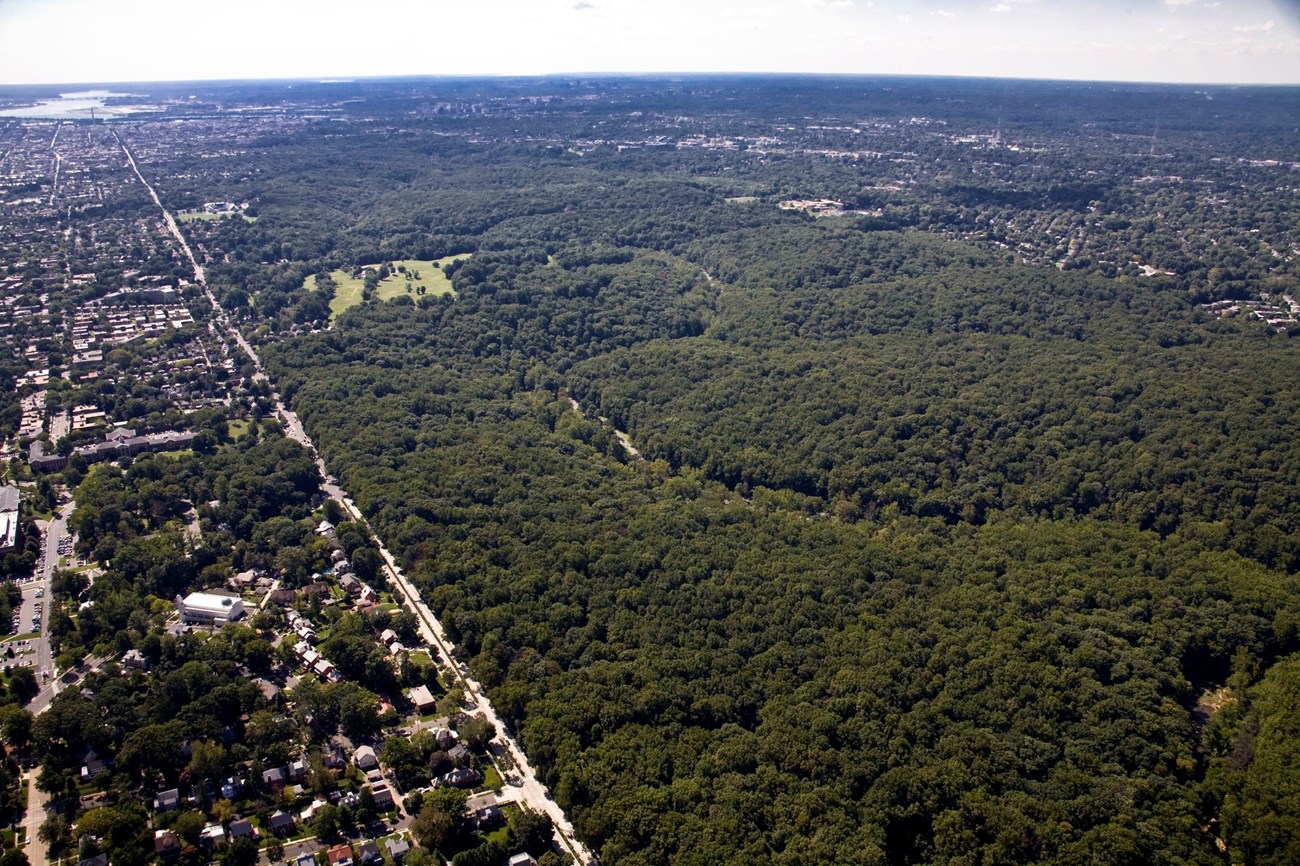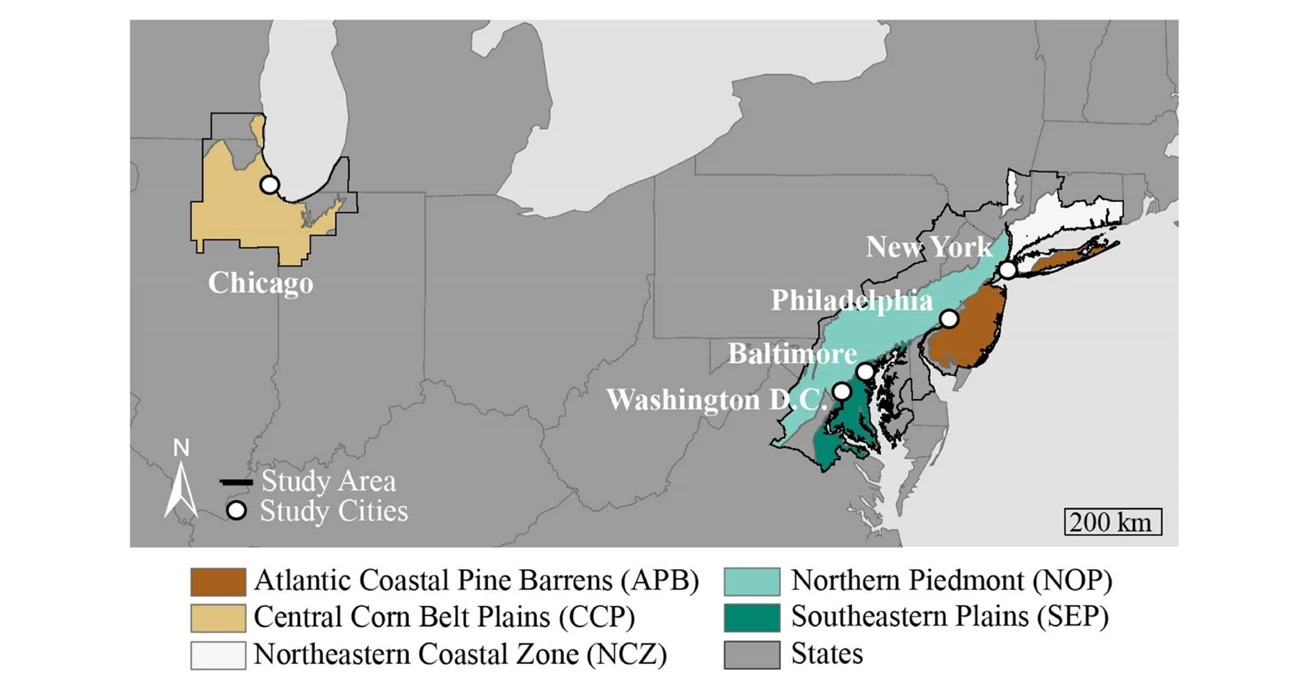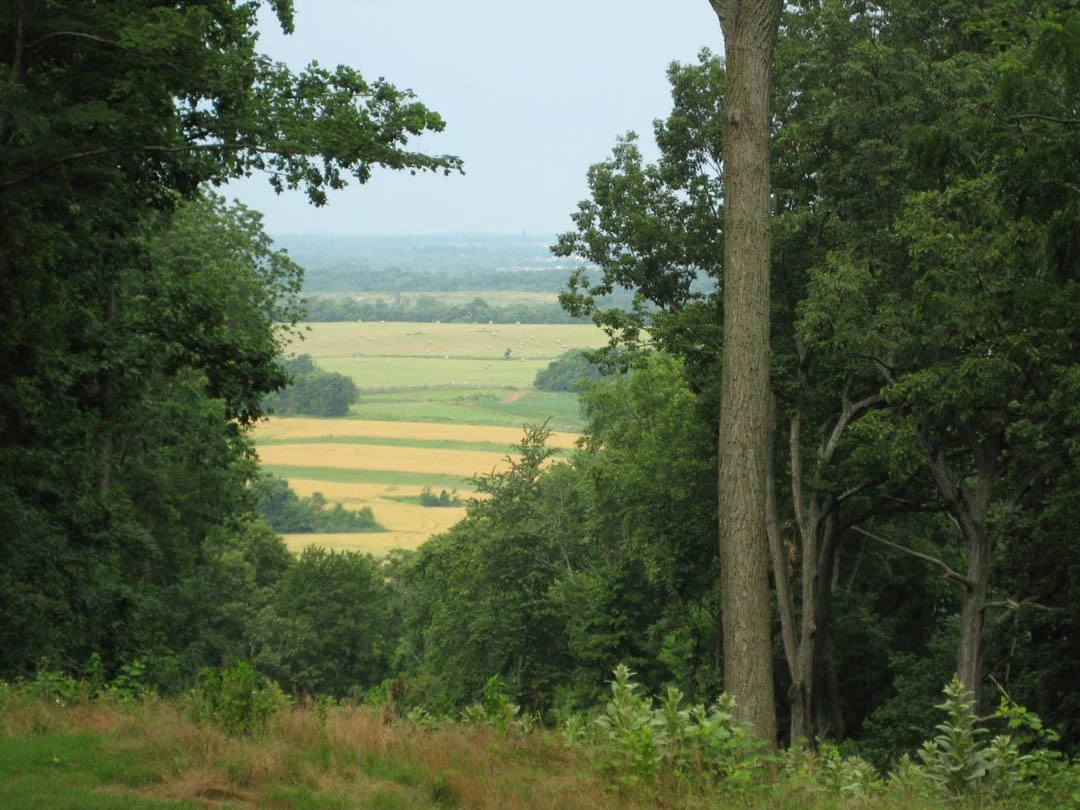Last updated: June 25, 2025
Article
Forest Health: Context Matters

NPS/Thomas Paradis
New research conducted by National Capital Region Inventory & Monitoring Network (NCR I&M) Quantitative Ecologist John Paul Schmit and others shows that the land surrounding forest plots can influence forest health. Forest plots surrounded by high canopy cover (i.e., more forest) are denser, more diverse, and have a lower percentage of non-native species than those surrounded by high impervious cover (e.g., pavement and concrete) or farmland. The study, published in Ecosphere, has management implications for forests in parks of the National Capital Region (NCR).
National Capital Region: A Diverse Landscape
Most of the land cover in NCR national parks is forested, but the surrounding land varies widely, including farms and urban development. These land uses can influence forest composition and structure, and understanding how can help inform park management decisions.
Landscape Context: Cities, Farms, and Forests
To understand how forest health varies across different landscapes, researchers studied forest plots in four metropolitan areas in the Eastern Deciduous Forest ecosystem—Baltimore-Washington, DC; Chicago; New York City; and Philadelphia—spanning five ecoregions: Atlantic Coastal Pine Barrens, Central Corn Belt Plains, Northern Piedmont, Southeastern Plains, and Northeastern Coastal Zone (Figure 1).

Schmit et al., 2025
The authors analyzed forest characteristics, including the variety of tree species, forest structure, and the presence of non-native trees across different surrounding land uses within one kilometer of the forest plot (landscape context). A large urban park like Rock Creek Park may contain forest plots that that are largely surrounded by canopy in the center of the park, or by high impervious cover at plots near the edge of the park.
They found that forest community composition, a look at tree species present and their abundance measured by basal area,1 was similar in forest patches surrounded by high canopy cover and those surrounded by farmland. Forest structure, which looks at the number of trees in a plot, their total basal area, and the distribution of different tree sizes, was similar between forests surrounded by high impervious cover and those surrounded by farmland.
1. Forest Community Composition: Plots Surrounded by Higher Canopy Cover are Healthier
In the Northern Piedmont, forest patches surrounded by high canopy cover generally had higher species diversity and tree density, and a significantly lower proportion of non-native trees, compared to patches surrounded by farmland and high impervious cover.
Tree species diversity was lower in forest plots surrounded by high impervious cover or surrounded by farmland in most ecoregions, including the Northern Piedmont and Southeastern Plains which encompass much of the NCR.
Forest community composition in plots surrounded by high impervious cover was generally more distinct from plots surrounded by farmland and high canopy cover, in which the species present and their relative abundance were similar. This difference was more defined in some ecoregions than others, particularly the Atlantic Coastal Pine Barrens and Central Cornbelt Plains.
2. Forest Structure: Forest Plots Surrounded by High Impervious Cover and Farmland Have Similar Structure
Overall, forests surrounded by high impervious cover had a structure similar to those surrounded by farmland. Plots surrounded by high canopy cover generally had greater basal area, tree density, and size diversity. In the Northern Piedmont, however, forests surrounded by high impervious cover had a higher basal area than those surrounded by high canopy cover.

NPS
Management Considerations
These findings illustrate that both ecoregion and landscape context can influence forest health and should be part of forest management considerations.
- Forests surrounded by high impervious cover have unique community assemblages across the board. In each ecoregion, tree community composition in forest plots surrounded by high impervious cover was distinct from those surrounded by high canopy cover and farmland. This distinction points to a need for different management strategies in highly urbanized forests.
- Forest structure is similar between forest plots surrounded by high impervious cover and farmland. These similarities point to common challenges and therefore an opportunity for shared management strategies.
- Patterns in forest composition or structure can't be explained only by looking at ratios of impervious cover and canopy cover on surrounding land. Other types of land cover, such as farmland, can play an important role in shaping forest communities and can be found throughout urban landscapes.
Further Reading
- Schmit, J.P., L.R. Johnson, M. Baker, L. Darling, R. Fahey, D.H. Locke, A.T. Morzillo, N.F. Sonti, T.L.E. Trammell, M.F.J. Aronson, M.L. Johnson. 2025. The influence of urban and agricultural landscape contexts on forest diversity and structure across ecoregions. Ecosphere 16(2):e70188.
- Brentjens, Emma. 2025. Forest Regeneration 2024. https://www.nps.gov/articles/000/forest-regeneration-2024.htm
- Johnson, L.R., Johnson, M.L., Aronson, M.F.J. et al. 2021. Conceptualizing social-ecological drivers of change in urban forest patches. Urban Ecosystems 24, 633–648.
- Lookingbill, T.R., Schmit, J.P., Tessel, S.M., Suarez-Rubio, M. and Hilderbrand, R.H., 2014. Assessing national park resource condition along an urban–rural gradient in and around Washington, DC, USA. Ecological Indicators, 42, pp.147-159.
1 the area of the plot covered by tree trunk
